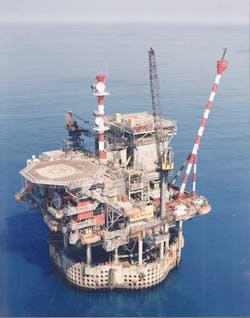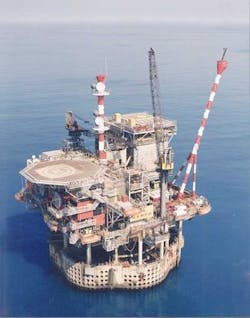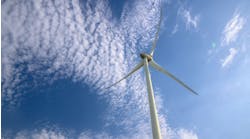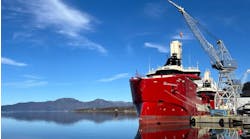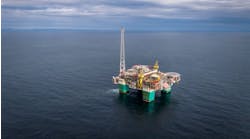Program to coordinate with Frigg platform removals
Jeremy Beckman
Editor, Europe
Total E&P UK has opened consultations over the future of its redundant MCP-01 platform. The 386,000-tonne structure, which includes a concrete gravity base, was installed in 1976 in the UK North Sea. Its main role was to serve as a pigging and compression station for gas transported through the Frigg pipeline system to eastern Scotland.
Decommissioning was originally planned for 2024. However, according to recent studies, future costs of maintaining a safe environment on the platform for periodic visits by operations and maintenance crews could rise substantially. Total E&P UK has therefore opted for an early decommissioning, possibly starting in 2006. The main activity will likely be coordinated with decommissioning of topsides and jacket removal operations on six platforms in Total E&P Norge's Frigg complex.
MCP-01, an acronym for manifold compression platform, is in 94 m of water in block 14/9, 170 km northeast of the St Fergus gas reception terminal.
Frigg's transportation system originally comprised two 32-in. pipelines. The "Norwegian" Frigg pipeline, recently renamed Vesterled, also accommodates gas produced from the Heimdal catchment area. A 24-in. spur line takes gas from Total E&P UK's Alwyn complex directly southeast to TP1 for subsequent feed-through into the Frigg UK line. Over the years, pressure-controlled gas from the Bruce, Captain, Ross, and Piper area fields have also been injected into the "UK" line.
In 1992, two pipelines were modified to pass through the bottom part of the concrete substructure, rather than via the deck. Topsides facilities associated with the lines were then cleaned and shut in. Thereafter, the only live process equipment on the platform has been associated with the tie-in of the 18-in. export spur line from the third party Piper area fields.
Whatever happens to MCP-01, Total E&P UK plans to maintain gas imports to St Fergus through the Frigg/ Vesterled lines for years to come. To ensure uninterrupted supply, work started this summer on a two-phase program to install new bypass sections for the two pipelines and the 18-in. spur line. Subsea 7 should by now have completed the first phase.
Ownership of the various facilities on MCP-01 is split among Total E&P UK, the Piper/Tartan Group (operated by Talisman), and Norway's Gassled partnership – the latter comprising 10 oil companies. Shared assets include the concrete substructure and integrated concrete support frame, secondary structures (topsides equipment), and the platform's utility and safety systems.
Much of the platform's total weight of 386,000 tonnes is taken up by the 373,000-tonne concrete substructure, including concrete and sand ballast. The topsides' dry weight is estimated at 13,000 tonnes, including a 900-tonne living quarters, helideck, diesel generators, diesel storage, and a temporary refuge on the south side of the platform.
"Maintenance is most problematic in areas featuring gratings and handrails," Lemercier says. "There are restricted areas which are out of bounds to all staff. The maintenance crew is changing gratings where possible to maintain safe access. We have removed other bits and pieces as soon as they constitute a hazard, but we have not been obliged to re-build any sections of the platform."
The topsides will be removed to the shore. If all goes to plan, cleaning could start in 2005, followed by removal during 2006-07.
"Currently, we are in the tender phase for the removal work," Lemercier adds. "We hope to award this contract in October. It is likely that one consortium of contractors could operate the entire project; i.e., both MCP-01 and the Frigg platform removal jobs."
The concrete gravity base, which is 100 m in diameter and 102 m tall, features a perforated Jarlan external wall with around 1,250 holes designed to reduce wave impact.
null
Four disposal alternatives have been considered for the concrete substructure:
- Re-float, tow to shore, demolish and dispose of onshore
- Remove external and internal steelwork, re-float and dispose of at a deepwater location
- Remove internal and external steelwork and cut down substructure to provide a clear draught of 55 m
- Leave in place, removing the external steelwork where practicable.
"We are looking at the technical feasibility, the risk to personnel, the environmental impact, and the potential cost in our comparative assessment of the disposal alternatives," Lemercier explains. "Doris Engineer- ing did the initial work in establishing a method statement for the four disposal options."
Other contractors involved in the program to date include Safetec in Stavanger for personnel safety analysis; Wood Group in Aberdeen for topsides removal studies; COWI in Copen-hagen for technical risk assessment; and DNV in Aberdeen and Stavanger for the environmental impact assessment. Independent specialists have contributed to the verification process.
Both the British and Norwegian authorities are involved in the decommissioning program for MCP-01, under the provision of the Frigg Treaty signed by the two governments in 1976.
"They have provided very good advice in this process," says MCP-01 decommissioning program manager Erik Hjelde. "We have also observed that there is a very good cooperation on the subject of decommissioning across the border, with good sharing of information, not just at departmental levels in Aberdeen and Oslo, but also between, for example, the UK's Northern Lighthouse board and the Norwegian Coastal Administration."
Total E&P UK is considering options for removal to shore for re-use, recycling, or disposal. But as a concrete platform, MCP-01 is a candidate for derogation under the conditions of Ospar Decision 98/3, which recognizes the difficulties of moving some large, heavy installations. The comparative assessment (EIA) of the various disposal options may therefore lead to the concrete substructure being left largely in place.
null
According to Hjelde, letters were sent in January to 49 potentially interested parties at the initial phase of the public consultation on the decommissioning of MCP-01.
So far, 12 potentially interested parties have been identified, including Scottish and English fishermen, Greenpeace, academics, and individuals.
"A draft of the environmental impact assessment report was presented at a stakeholders' workshop in London in May, having also been sent to the participants in advance," Hjelde says. Stakeholder suggestions will be incorporated into the decommissioning proposal, which will then be submitted to the authorities in the UK and Norway for consideration. A three-month review is then expec-ted, followed by statutory 45-day consulta- tions over the entire document.
As MCP-01 is technically very similar to the Frigg CDP1 platform, experience will be transferred up to a point from the previous disposal studies for the Frigg Field Cessation Plan, which took four years from start-up to final approval. Over the last few years, DNV has refined a methodology for assessing non-quantifiable environmental impacts of offshore installation, decommissioning, and disposal. This method was used for other recent large decommissioning projects such as Ekofisk and Frigg.
Bypass project
Late in July, Total shut down the 360-km UK Frigg pipeline for about one month to allow installation of new sections, which will bypass both the TP1 and MCP-01 platforms. The UK Frigg line normally has transport capacity of 32 MMcf/d, although throughput prior to the shutdown was closer to 16-19 MMcf/d. The pipeline serves around 20 fields providing 15% of the UK mainland's needs. Spur lines tie in supplies from Bruce upstream of MCP-01, Captain and Ross downstream of the platform, and the Piper area fields via a direct link to the installation.
Bypass works were timed to coincide with maintenance shutdown programs at Alwyn, Bruce, and St Fergus. Following shut-in of the Alwyn and Bruce platforms and the various spur lines, Frigg UK was depressurized to 28 bar via compression facilities at St Fergus. Two high-pressure isolation tools (HPITs) were then launched into the pipeline from TP1, propelled with seawater. One was positioned via acoustic equipment in the 24-in. Alwyn line just northwest of TP1, while the other was set just to the south of this platform in the 32-in. line. A third tool was launched from St Fergus using seawater and set into position just north of MCP-01. Once all HPITs had been set, the flooded sections of the pipeline were depressurized to around 10 bar.
As the Alwyn export line approaches TP1 from the northwest, it crosses the Frigg UK export line. Twenty-five meters west of this point, a subsea skid has been placed on the seabed, comprising 24 and 32-in. pipework and valves for joining the new sections of the bypass lines.
Following flooding and isolation, both the 24 and 32-in. lines were cut 25 m up and downstream of the crossing point, an operation involving de-burial and raising of 100 m of the 32-in. line to ensure access for concrete removal, cutting, and welding. The 24-in. line is not buried, but the concrete coating still had to be removed close to the cuts. Around 370 sq m of seabed was affected at each location.
Both pipelines were then connected back to the subsea skid using a 30-m long, carbon steel spool piece, hyperbarically welded into place at the cut pipeline end with a flange connection employed at the subsea skid end. The spools are concrete weight coated, and the affected parts of the lines have since been rock-dumped. Once both bypass operations were complete, the HPITs were recovered to the subsea skid for removal.
The pig launchers were then removed and replaced with a U-shaped transition spool to join together the two pipeline sections.
For the Frigg UK line bypass, a 1.8-km long, 32-in. pipe housed in a 40-in. bundle was installed east of MCP-01 beyond the 500-m safety zone. This operation was performed by two tugs, using the controlled-depth tow technique, followed by flooding of the bundle.
Isolation of the Vesterled line, scheduled for next summer, will follow the same methodology, with an HPIT launched this time from Heimdal and set in position just west of MCP-01. This bypass line will have the same dimensions as the Frigg UK bypass section. In this case, cuts will be made to the existing 32-in. line 1-km north and south of MCP-01. A short tie-in spool will be used to join the existing line to the 40-in. bundle.
Once welding has been completed, the flooded pipelines will be de-watered to the sea from valves in the MCP-01 bypass sections. Both bypass operations are being managed by Subsea 7 under a $70-million contract.
Vessels involved in this work were the DSVs Pelican, Toisa Polaris, and Bar Protector; the survey vessel Highland Eagel; Tideway's rock-dumper Rollingstone, and water-winning barge Brabo.
